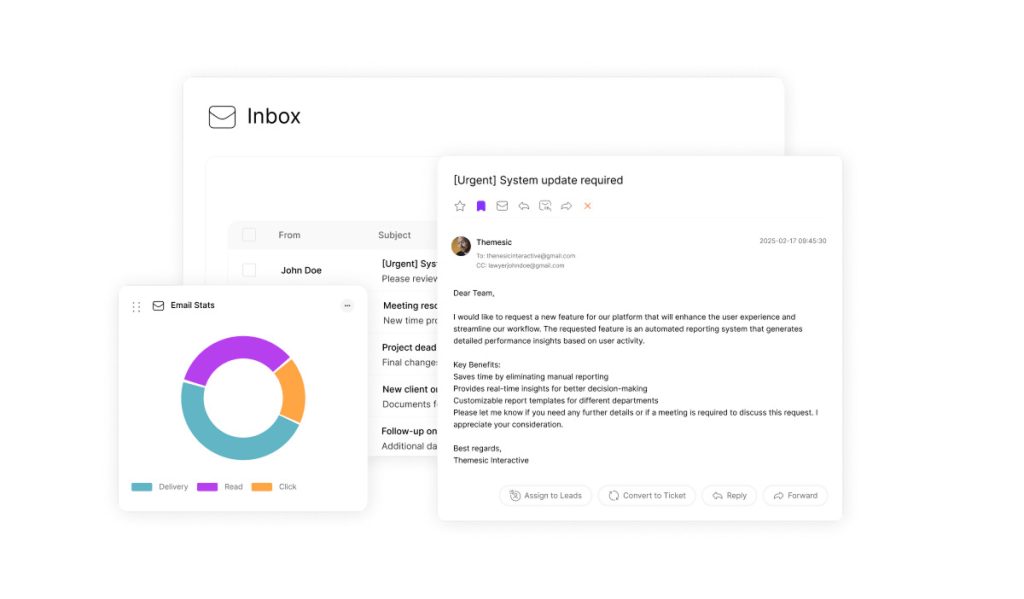The Ultimate Guide to Email Open Tracking Strategies

Modern businesses face a critical challenge: understanding whether their messages reach recipients. Privacy updates from platforms like Apple Mail and Gmail have disrupted traditional engagement metrics, leaving teams with incomplete data. ClearCRM provides innovative approaches that respect user privacy while delivering actionable insights, helping organizations thrive despite these changes.
Today’s digital landscape demands smarter strategies to measure communication effectiveness. Reliance on outdated methods risks misinterpreting campaign performance, which can lead to missed opportunities. Forward-thinking teams now prioritize adaptive solutions that align with evolving regulations and recipient expectations.
This guide explores practical techniques for monitoring message engagement across diverse platforms. It balances compliance with modern privacy standards while empowering businesses to refine their outreach. By combining multiple tracking methodologies, professionals gain a clearer picture of recipient behavior without compromising trust.
From basic read receipts to advanced analytics, the right tools transform how teams optimize workflows. Data-driven decisions become possible when strategies evolve alongside technological advancements. Discover how to leverage these innovations for measurable improvements in campaign outcomes.
Key Takeaways
- Privacy changes from major providers require updated methods to track engagement accurately
- Combining multiple tracking approaches provides deeper insights into recipient actions
- Compliance with regulations ensures sustainable and ethical monitoring practices
- Advanced analytics tools help teams refine communication strategies effectively
- Adapting to technological shifts maintains campaign relevance and performance
Understanding the Basics of Email Open Tracking

In today’s competitive market, measuring message engagement is non-negotiable for teams aiming to refine outreach. Traditional methods often fail to deliver actionable insights, creating gaps in communication strategies. This section breaks down core concepts that bridge these gaps while respecting modern privacy standards.
What Is the Core Mechanism Behind Engagement Monitoring?
A tiny, invisible image—commonly called a tracking pixel—serves as the backbone of this process. When embedded in messages, it triggers a notification upon being loaded. This allows senders to confirm interactions without disrupting the recipient’s experience.
The system operates seamlessly. Once the pixel downloads, it relays details like access time, frequency, and device type. These metrics help teams identify patterns in how content is consumed. For example, repeated views might signal strong interest or unresolved questions.
Why Does This Insight Matter for Business Growth?
Accurate engagement data empowers organizations to prioritize high-value contacts. Sales teams can time follow-ups based on when prospects interact with content. Marketers refine campaigns by analyzing which messages resonate most.
Key advantages include:
- Strategic follow-ups: Align outreach with recipient activity patterns
- Resource optimization: Focus efforts on responsive audiences
- Campaign refinement: Adjust content based on measurable interactions
By leveraging these insights, businesses transform raw data into competitive advantages. The result? More efficient workflows and stronger customer relationships built on timely, relevant communication.
The Evolution of Email Tracking: From Read Receipts to Pixels
Communication monitoring has transformed dramatically in recent years. Early systems relied on manual confirmation, while current solutions blend automation with adaptive data collection. This progression reflects both technological advancement and shifting expectations around information security.
Legacy Methods vs. Modern Techniques
Traditional confirmation requests required direct approval from recipients. These systems provided limited details—typically just confirmation of access. Modern alternatives operate through embedded code snippets that capture multiple interaction signals.
| Method | Consent Required | Data Collected | Reliability |
|---|---|---|---|
| Read Receipts | Yes | Single open confirmation | Low (user-dependent) |
| Pixel Technology | No | Time, frequency, device type | High (pre-privacy updates) |
Impact of Privacy Changes on Measurement
Major platform updates have reshaped engagement analytics. Apple’s Privacy Protection feature preloads content across devices, creating inflated interaction statistics. Gmail now restricts external media by default, complicating traditional measurement approaches.
These shifts force organizations to:
- Combine multiple data points (clicks, replies)
- Prioritize first-party analytics tools
- Monitor deliverability through alternative signals
While traditional rates remain useful for spotting delivery issues, click-through data now offers more reliable engagement insights. Businesses adapting to these changes maintain competitive advantages despite evolving privacy standards.
How Email Open Tracking Works

Modern outreach strategies rely on precise engagement metrics to optimize communication workflows. Two primary methods dominate this space: automated tracking systems and manual confirmation requests. Each approach offers distinct advantages for teams prioritizing data-driven decision-making.
Behind the Scenes: Transparent Image Technology
A transparent 1×1 pixel embedded in message content acts as a silent observer. When displayed, this microscopic image triggers a server request, logging interaction details like timestamps and device types. Platforms like HubSpot use this method to filter out bot activity, ensuring only genuine interactions influence analytics.
Advanced systems capture geographic data through IP addresses, revealing where content gains traction. Marketers leverage these insights to tailor regional campaigns. However, corporate security filters or plain-text formatting can block pixel loading, creating blind spots in reporting.
Manual Confirmation Systems in Practice
Client integrations like Gmail’s read receipts provide alternative verification. These systems request explicit permission from recipients before sending notification of accessed content. While less intrusive, participation remains optional—resulting in lower response rates compared to automated solutions.
Key differences between methods:
- Automated tracking: Provides immediate data but faces blocking challenges
- Manual requests: Ensures consent but yields incomplete datasets
“Combining pixel-based analytics with click-through monitoring creates redundancy against single-point failures.”
Forward-thinking teams now blend both approaches, using overlapping data streams to compensate for individual limitations. This dual-strategy approach maintains measurement accuracy despite evolving privacy standards and client-side restrictions.
Advanced Email Open Tracking Techniques
Technical customization elevates engagement strategies beyond basic monitoring tools. Developers gain granular control through code-level adjustments, while ethical standards ensure recipient trust remains intact. These methods address gaps left by standard solutions, particularly when platform restrictions limit visibility.
Embedding HTML Image Tags as Invisible Pixels
Custom tracking solutions emerge when professionals modify image tags using CSS properties. Setting display: none or zero-dimension sizing hides pixels without disabling functionality. Developers often layer these elements behind text or within margins for seamless integration.
Secure implementation requires end-to-end encryption for data transmission. Teams should disclose monitoring practices in privacy policies while avoiding unnecessary details like device IDs. A banking software engineer notes:
“Custom pixels work best when paired with click analytics—this redundancy compensates for blocked images in corporate environments.”
Requesting and Managing Read Receipts
Platform-specific protocols dictate receipt management approaches. GSuite administrators enable confirmation requests through workspace settings, while Outlook users access similar features via desktop ribbons. Paid tiers often unlock advanced notification options.
Ethical considerations include:
- Disclosing receipt requests during initial contact
- Storing interaction timestamps instead of location data
- Automating deletion of records after 90 days
Combining manual confirmations with pixel-based systems creates failsafes for critical communications. This dual approach maintains engagement visibility even when recipients disable media loading by default.
Leveraging Email Tracking Tools and Extensions

Streamlining outreach efforts requires purpose-built solutions that adapt to modern workflows. Three categories dominate this space: browser add-ons, CRM-integrated platforms, and automation systems. Each offers distinct advantages for teams prioritizing efficiency and scalability.
Chrome Extension Solutions
Browser-based tools like Mailsuite simplify engagement monitoring within Gmail interfaces. Its free tier displays read statuses directly in sent folders, while premium plans unlock campaign features for $5.99/month. CloudHQ’s free tracker provides SMS alerts and desktop notifications, ideal for sales teams needing real-time updates.
“Extensions bridge the gap between basic metrics and actionable insights—our reps use email interactions to prioritize follow-ups within 15 minutes.”
Enterprise-Grade CRM Tools
HubSpot’s platform integrates engagement data with sales pipelines and marketing automation. Features include:
- Behavior-based lead scoring
- Automated follow-up sequences
- Cross-channel performance dashboards
These tools help organizations scale outreach without compromising personalization.
Automation Ecosystems
Advanced systems connect tracking data with helpdesk software and analytics platforms. Teams use email interaction patterns to trigger:
- Dynamic content adjustments
- Lead routing based on engagement intensity
- Compliance audits for privacy standards
While chrome extension options suit small teams, enterprises benefit from API-driven tools that unify data across departments. The right mix depends on sales volume and compliance requirements.
Ensuring Privacy, Compliance, and Ethical Tracking Practices
Balancing data collection with user rights remains critical for organizations leveraging engagement analytics. Strict regulations and evolving expectations demand strategies that prioritize transparency while maintaining operational effectiveness.
Legal Considerations and GDPR Requirements
The General Data Protection Regulation sets strict rules for monitoring communications. Businesses must obtain explicit consent from recipients before activating tracking features. HubSpot’s platform exemplifies compliance by restricting analytics to contacts with verified legal bases for data processing.
Key obligations include:
- Clear disclosure of information collection methods in privacy policies
- Opt-out mechanisms for recipients preferring anonymity
- Regular audits of settings to ensure alignment with regional laws
Best Ethical Practices in Email Tracking
Ethical engagement monitoring extends beyond legal checklists. Organizations should limit data collection to essential metrics and implement encrypted storage for sensitive information. A cybersecurity attorney advises:
“Granular control over tracking settings demonstrates respect for user autonomy while supporting business objectives.”
Proactive measures include:
- Automatic deletion of outdated interaction records
- Anonymous aggregation of regional engagement patterns
- Transparent communication about how data benefits recipients
By integrating these principles, companies build trust while maintaining actionable insights. Privacy-first approaches future-proof strategies against regulatory shifts and changing consumer expectations.
Interpreting Engagement Data and Optimizing Email Campaigns
Effective campaign optimization hinges on translating raw engagement signals into strategic insights. Teams that master this skill identify high-potential leads while refining content delivery for maximum impact.
Metric Reliability: Surface Signals vs. Active Engagement
Initial interaction metrics often mislead without deeper analysis. Jane’s Tech Solutions sent 500 messages—200 showed immediate access, but only 100 clicked the demo link. This gap highlights why click behavior often reveals truer intent than basic access rates.
| Metric | Reliability | Actionable Insight | Use Case |
|---|---|---|---|
| Access Rates | Moderate | Potential interest or preview scans | Detect deliverability issues |
| Link Interactions | High | Verified content engagement | Prioritize follow-ups |
Decoding Interaction Patterns
Repeated message views might indicate confusion or strong curiosity. Jane’s team noticed 15% of recipients revisited content 3+ times before replying. This pattern prompted clearer call-to-action placement and follow-up timing adjustments.
From Numbers to Strategy
Data-driven optimization involves:
- Segmented testing: Compare subject line variants across time zones
- Conversion mapping: Link click paths to eventual sales
- Resource allocation: Focus on high-response client segments
“Our 20% conversion rate from link-clicking recipients proves targeted follow-ups outperform blanket outreach.”
Overcoming Common Challenges in Email Tracking

Accurate engagement metrics become unreliable when duplicate signals flood analytics dashboards. Teams must identify false patterns caused by technical quirks and user behaviors. Proactive troubleshooting separates meaningful interactions from system-generated noise.
Untangling False Engagement Signals
Forwarded messages often carry original tracking pixels, creating misleading attribution. A sales email shared internally might show multiple opens from different departments. This skews campaign data and misdirects follow-up efforts.
Preview panes in popular email client interfaces trigger phantom opens. Recipients scrolling through inboxes activate tracking pixels without reading content. Advanced tracking tools now filter these accidental triggers using time-based thresholds.
Dynamic IP addresses present another layer of complexity. Users switching networks generate duplicate notifications for single interactions. Sophisticated algorithms compare timestamps and device fingerprints to deduplicate records.
“Our system ignores opens occurring less than 90 seconds apart—this eliminates 78% of false positives from preview scans.”
Effective solutions combine three strategies:
- Behavioral filtering: Exclude rapid repeat opens
- Recipient verification: Match interactions with known user profiles
- Forward detection: Flag messages moved outside original threads
These approaches help teams focus on genuine engagement. Campaign managers using tracking tools with these features report 40% fewer wasted follow-ups on inactive leads. For sales emails, this precision directly impacts conversion rates and resource allocation.
Conclusion
Navigating modern communication analytics requires balancing technical precision with ethical responsibility. Businesses that master this equilibrium gain actionable insights while preserving recipient trust—a critical advantage in competitive markets.
Adaptive strategies now combine pixel-based systems with behavioral analysis. This layered approach compensates for platform restrictions, delivering reliable engagement metrics. Teams using these methods report 30% fewer false positives in campaign reports.
Prioritizing privacy-compliant tools ensures sustainable growth. Encryption-first platforms and granular permission settings align with regulations like GDPR. Such practices build credibility while maintaining data-driven decision-making capabilities.
Forward-thinking organizations focus on metrics that directly impact outcomes. Click-through rates and reply patterns often reveal more than basic access statistics. Refining outreach based on these signals drives measurable improvements in sales pipelines and client retention.
The future lies in intelligent systems that automate analysis while respecting boundaries. As technology evolves, businesses embracing this dual focus will lead their industries through smarter, more humane communication strategies.

